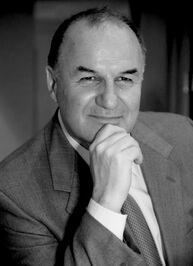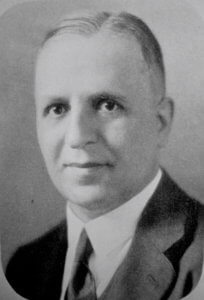VATRA’S CALENDAR PAGE/
Faik Konitza (March 15, 1875 – December 15, 1942)-Foto:Faik-Konica-October-1926_The-Mayflower/
Thanks to the acclaimed journalist Ilir Ikonomi, who is the author of a historic monograph on Faik Konitza, Dielli brings to the reader the original English text of ALBANIA, 88 years after printing its translation./ THE MAYFLOWER/
THE MAYFLOWER/
By Ilir Ikonomi/
 When Faik Konica was King Zog’s envoy in the United States, he rented a suite in The Mayflower Hotel, the second best address in Washington D.C. after the White House. Konica’s suite which also served as the Legation of Albania, was located on the second floor of the building, facing Desales Street and had the plaque Albanian Republic on the door. Sadly, over the years, this part of the hotel has been completely transformed and the original suite does not exist anymore.
When Faik Konica was King Zog’s envoy in the United States, he rented a suite in The Mayflower Hotel, the second best address in Washington D.C. after the White House. Konica’s suite which also served as the Legation of Albania, was located on the second floor of the building, facing Desales Street and had the plaque Albanian Republic on the door. Sadly, over the years, this part of the hotel has been completely transformed and the original suite does not exist anymore.
Just like Konica, a number of Senators, administration officials and other celebrities had made The Mayflower their primary residence, for it was the meeting place of the rich and famous. The hotel was aptly nicknamed the Grande Dame of Washington.
When I embarked on writing about Konica I learned with great excitement of the existence of a monthly magazine that kept notes on the celebrity guests and other visitors of the hotel. The historian of The Mayflower guided me through the many issues of The Washingtonian and there I was able to find a few things: In the February 1929 issue of the magazine, a writer named Margaret B. Downing had a few notes about the Albanian minister. At that time, Konica had just returned from a trip to Albania, during which King Zog had promised to promote him to prime minister, as I later learned with great surprise. For reasons hard to explain, Konica never went back to fill the post.
Here is what Downing writes:
“The return of Dr. Faik Konitza of Albania is greeted with cheers. He is one of the bachelors of the corps. But he has important claims to distinction, such as that of having written a novel, which had an unbelievably large circulation for a philosophical-politico work of fiction. It was called “Doktor Gjelpera” but unfortunately has never been translated . Few novel readers of these days understand the cultured language of Durazzo. Dr. Konitza has filled roles which might be compared to Benjamin Franklin’s if that renowned patriot had pleaded the cause of the colonies in Vienna, Berlin and Madrid as successfully as he did in Paris. In 1909, when the first mutterings of Albanian revolt against the Turkish yoke alarmed Europe, he went successively to London, to Rome, to Vienna and Paris and everywhere converted the chanceries to his way of thinking. He was in the actual revolutions in 1912 and 1913 and in the interim he published a journal of liberation in Brussels. Of a renowned and historic family of Albania, the Minister has powerful relatives in every department of its life, military, social, literary, and in political groups about the new ruler.”
In the September 1930 issue, I discovered a long article written in English by Faik Konica, which was subsequently translated into Albanian by Gjon Mili, an Albanian-American photographer best known for his work published in Life magazine. The Albanian translation was printed in Dielli of October 14, 1930. While the Albanian translation is widely known, the English original was considered lost. I believe the English text in The Washingtonian is precisely the original I had been looking for.
Here is the article in full:
ALBANIA By FAIK KONITZA, Minister of Albania to United States
By FAIK KONITZA, Minister of Albania to United States
“Albania is a strange, tragic country. There was the first altar to Zeus the Thunderer. He was called Zeus the Thunderer because in this country – winter and summer – are continual thunder storms and violent rains.” This speaks Isadora Duncan in that fascinating book of hers, My Life (p. 281 of the 1927 New York edition). And Isadora’s description is true enough, but true only of some parts of Albania, not of the country in general. Because there are places in Albania that are like exquisite perennial gardens, never touched by winds and storms. Such is, for instance, Tirana, the capital. I was there in January 1929, and while the nearby mountains, surrounding the city as in a close circle, were covered with snow and clouds, in the city itself huge rose trees were in full bloom. As a matter of fact, if I were asked to give in one phrase an idea of the physical aspect of Albania, I would say that its chief characteristic is a great diversity of climates within a small area, the diversity being the result of the intricate net of high mountains and low valleys that cover its surface. In this respect there is some resemblance to Southern California.
Albania is situated on the Eastern shore of the Adriatic Sea and, with an area almost equal to that of Belgium, has only a population of one million and two hundred thousand inhabitants. The Albanians speak a very old language of their own, distantly related to Latin, Greek, Teutonic, Sanskrit and others, – in other words it is one of the so-called Indo-Germanic languages. But most Albanians, in addition to their own language, have a smattering of Italian and French, and sometimes even English, and the casual visitor from abroad gets along easily enough. Albania may be reached by many ways. But the shortest and easiest way is through Italy, either by boat from the Italian city of Bari on the Western shore of the Adriatic, to the Albanian city of Durazzo on the Eastern shore, – or by aeroplane from Brindisi to Valona across the Otranto Channel. By boat, it takes about nine hours, while by air it takes some 45 minutes to cross from Italy to Albania.
I would give the preference to the steamer leaving Bari late in the evening and reaching Durazzo very early in the morning. Durazzo built in the year 627 before Christ, was in 48 the scene of a celebrated battle between Caesar and Pompey, and for generations has been the Atlantic City of the Roman Empire : The poet Valerius Catullus calls it “the meeting-place of the Adriatic (Durrachium, Adriae taberna). It is now a modest place but not without certain air of greatness with its mediaeval towers and the King’s summer castle built on a lofty hill hovering above the city. From Durazzo it is twenty miles to Tirana, the capital, and from there, either by car or by air, one can visit the rest of Albania, go south towards Korcha and Girokastra, or go North towards Croya and Shkodra. The last named city was the capital of Illyria (Albania was called Illyria in the old times). Scutari is probably the most interesting place in present-day Albania, and its silversmiths and other craftsmen are famed through all Southeastern Europe.
A visitor will expect to find in Albania a good deal of color, to see gorgeous or picturesque costumes, especially if he happens to have admired in the National Portrait Gallery of London the portrait of Lord Byron in Albanian costume or read in Childe Harold the poet’s sonorous verses on Albania and the Albanians. He will not be entirely disappointed, in spite of the efforts made by some ill-advised persons over there to stamp out the national costume, in the mistaken belief that picturesqueness and culture could not go together. There is still plenty of color; and, because the Albanians are known to be so individualistic, there is variety as well as color. Almost every district has its own special costume though all these costumes have, or until recently had, some feature in common; for instance, black and white as the main colors, and the habit of letting the sleeves fall behind instead of wearing them: The Elizabethan poet Spenser, in his Faerie Queene (III, XII, X) has this verse:
“And sleeves dependaunt Albanese wyse”
There has long been some idea that Albanians dislike foreigners and do all they can to discourage visitors. The English historian, Gibbon, in his “Decline and Fall of the Roman Empire” writes something to that effect. And when, at the beginning of the Nineteenth Century, Lord Byron decided to visit Albania, Shelley wrote him a letter to warn him off. Byron nevertheless went to Albania where he stayed a long time; and the letters that he sent to his mother, even more than the stanzas in his poem of “Childe Harold”, show his delight with the country and the people. More recently, Count Hermann Keyserling (“Europe”, New York, 1928, p. 320) has said that “the Albanian is, as a type, the immortal noble-minded robber”. It may be that the Albanian people, having lived as well as inherited bitter experiences of invasions and wars, has in bygone days been reluctant to allow free access to possible surveyors and makers of military maps in view of future operations; and often harmless travelers may have suffered from such suspicions. But this attitude of mind is now luckily a thing of the past. I will very seriously declare is now by far the best regulated State in the Haemus Peninsula: nowhere in that part of the world is there more order and security than in Albania. I would shrink from saying it myself, if impartial visitors from the outside had not repeatedly declared it before me.
The man Albania has chiefly to thank for the order that reigns everywhere is its young sovereign King Zog. I am glad that the American press, now better informed and less accessible to spurious propagandas, recognizes the extraordinary capacities of this ruler of genius. Because Albania geographically and politically is, as they say, “a key position”, its importance is out of proportion to its area , and it cannot be indifferent to the outside world whether such a country is successfully governed or not. King Zog, in addition to being a man of decision and energy, has a personality of great charm. Tall, slender, with large blue eyes, he loves simplicity and naturalness, reducing ceremonies to the minimum. He has a sense of humor, and enjoys a witticism or a good joke. Besides Albanian, he speaks French and German. Whenever the affairs of State allow him a respite he loves to indulge in his favorite sports which are riding, hunting, and swimming. Being still unmarried, he is assisted in Court functions by the princesses, his sisters, charming and simple girls who try to keep as much as possible out of the lime-light but cannot escape the respect and affection of their people.
I have just jotted down a few notes fearing that a more formal contribution would bore the casual reader. I hope this may induce some readers to know more about the country of Albania.
EDITOR’S NOTE: Mr. Faik Konitza who writes a few notes on Albania in this issue of The Washingtonian, has represented his country in the United States since 1926. He is a scholar, and is said to have contributed more than anybody else to the making of a literary language out of the old colloquial language of Albania. He spends most of his time in his private library, though he now and then likes to meet people. He has been living at The Mayflower during the last four years.
